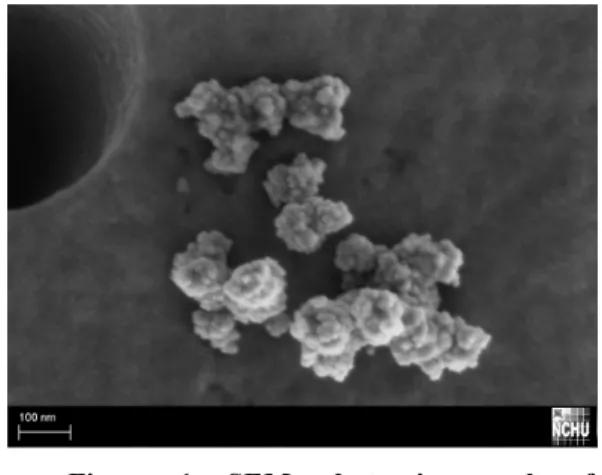2011 International Conference on Aerosol Science and Technology
ELECTRON MICROSCOPY OBSERVATIONS OF DIESEL ENGINE AND WORKPLACE AEROSOLS Pei-Hsuan Chen, Yi-Jyun Liou, Wei-Lun Chang, Yun-Hua Lin, Li-Hao Young*
Department of Occupational Safety and Health, China Medical University, Taichung 40402, Taiwan *Corresponding Author, Tel: +886 4 22053366 Ext.6219, E-mail: lhy@mail.cmu.edu.tw ABSTRACT
The impact of aerosols on human and environmental health is closely related to the aerosol size and shape, in addition to its concentration and chemical composition. The primary objective of the present study is to determine the morphological characteristics of aerosols from diesel engine exhaust and workplace metal buffing process. Diesel engine particles (DEPs) were directly collected on polycarbonate membrane filters using filtration, whereas the surface-deposited buffing-generated particles were collected and then transferred to the membrane filters. Prior to field emission scanning electron microscopy (FE-SEM) observations, the filters were T and RH conditioned and coated with a thin layer of Platinum. The results show that the DEPs are predominantly compact-aggregates composed of primary particles in the size range of ~30 nm. It appeared that the surface of DEPs was coated with condensed materials. The buffing process produced two distinct types of particles: one of irregular flake-like particles and the other of spherical particles. The flake-like particles are in the micrometer size range, likely produced as a result of mechanical removal from the metal products. The spherical particles are in the nanometer to micrometer size ranges, likely originate from molten metal debris which then solidified after cooling in the ambient air. The above qualitative results indicate that the morphology of particles emitted from diesel engine and metal buffing process could largely deviate from spherical shape, i.e., the common assumption. The particle effective density derived from mass-number measurements and
particle elemental composition will be presented.
Keywords: Scanning electron microscopy, Morphology, Diesel engine particles, Metal buffing process
INTRODUCTION
Airborne submicrometer and ultrafine particles affect human and environmental health in various ways, including increased mortality rate and respiratory symptoms, impaired visibility, and changes in atmospheric radiative balance.1,2
In Taiwan, PM2.5 consists of 80% or more
PM1, whereas ultrafine particles make up also
more than 80% of the particle number concentration.3,4 Many studies have shown the
toxicity and environmental impact potential of aerosols are negatively correlated with particle diameter. In addition, the transport, optical properties, and filtration efficiency of particles are also a strong function of particle diameter. However, it is important to note that unless the particles are spherical the “diameter” thus has a precise meaning, whereas atmospheric aerosols are often non-spherical, especially the fractal-like agglomerates or aggregates exhibited by combustion-generated particles.5,6 In such
case, the assumption of spherical particles with unit density (i.e., aerodynamic diameter) may in fact lead to erroneous estimation and conclusion. The present study aims to determine the morphological characteristics of aerosols from diesel engine exhaust and workplace metal buffing process. The results are expected to provide important implications in human and environmental health assessments.
2011 International Conference on Aerosol Science and Technology
FIGURES AND TABLES
Figure 1. SEM photomicrograph of compact-aggregates of soot particles in diesel engine exhaust.
Figure 2. SEM photomicrograph of flake-like and spherical particles of various sizes from metal buffing process.
Acknowledgments
The authors would like to thank all the workers who have participated in the study. The financial support from the CMU (97-250) and NSC (99-2628-E-039-001) are gratefully acknowledged.
REFERENCES
1. US EPA, National Center for Environmental Assessment-RTP Office, Office of Research and Development, US EPA, EPA/600/P-99/002bF, 2004.
2. Bellouin, N.; Boucher, O.; Haywood, J.; Reddy, M.S. Nature 2005, 438, 1138-1141. 3. Li, C.-S.; Lin, C.-H. Aerosol Sci. Technol. 2002, 36, 469-473.
4. Wang, Y.T. China Medical University, Master thesis, 2009.
5. Park, K.; Kittelson, D. B.; McMurry, P. H., Aerosol Sci. Technol. 2004, 38, 881-889. 6. Burtscher, H. J. Aerosol Sci. 2005, 36, 896-932.
